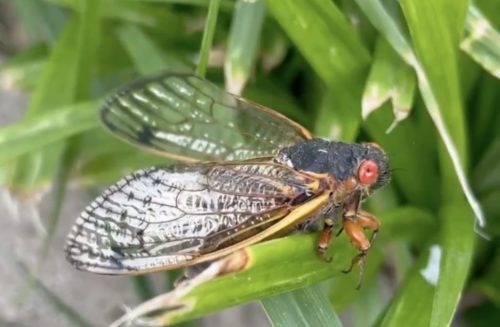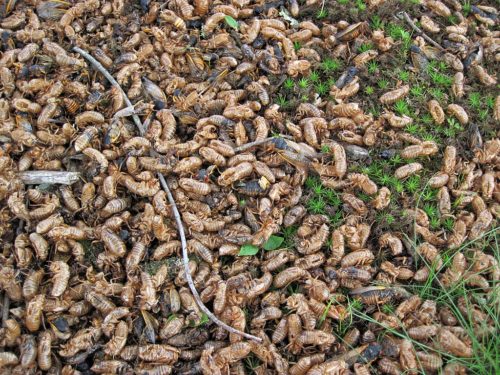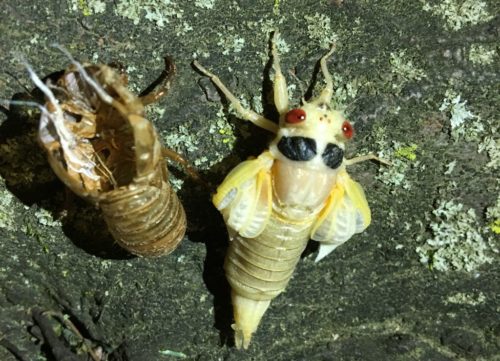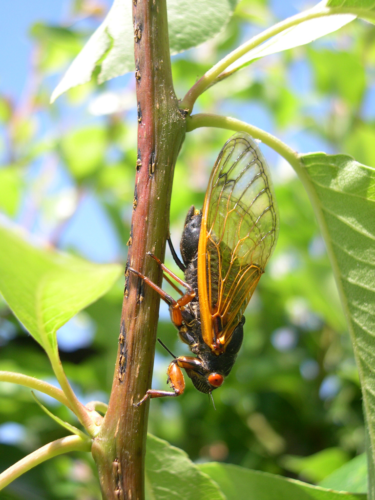Something unusual is happening in the eastern United States: insects that have been underground for 17 years are coming out in great numbers, mating, and making lots of noise. In a few weeks, they’ll disappear for another 17 years.
The insects are known as cicadas. Adult cicadas are an inch or two (2-5 centimeters) long. They have large red eyes and lacy orange wings.
Most insects have fairly short life spans. That’s also true for some kinds of cicadas, which only live for a year.

(Source: CarrieIrwinYoga.)
But the cicadas coming out now aren’t just any cicadas, they’re periodical cicadas, and they’re only found in North America. The “periodical” part of the name comes from their unusual life cycles. They spend a period of 13 to 17 years underground. Then they come out for just a few weeks before dying.
This year’s cicadas are known as Brood X, and they’re on a 17-year cycle. That’s a longer life span than any other kind of insect. These cicadas have been living in the ground as “nymphs” since 2004. The nymphs survive by drinking liquid from the small roots of trees.

(Source: James St. John [CC BY 2.0], via Wikimedia Commons.)
Scientists still don’t know how the nymphs keep track of time. But somehow, after 17 years, the nymphs all come out of the ground at about the same time.
The cicada nymphs begin climbing up nearby trees or bushes. That’s where they’ll make their final body change: they “molt”, coming out of their old skin and leaving a dried shell behind. After a few days, the cicada’s outer body hardens and it is fully adult.

(Source: Martha Weiss [CC BY 2.0] Friend to Cicadas.)
Then the cicadas begin mating. This is what they’ve been waiting 17 years for. And because they’ve all come out at the same time, there are lots of other cicadas around to mate with.
Male cicadas make loud calls to attract the females. Often, lots of males – sometimes tens of thousands of them – sing at the same time. When this happens, it can be incredibly loud – even louder than standing close to a powered lawnmower.
After mating, the female climbs a living tree or bush and digs nests for her eggs in a small branch. Females can lay up to 600 eggs.

(It looks like an extra black leg at the back).
[CC BY 2.5], via Wikimedia Commons.)
In just a few weeks, the adults will have reached the end of their long lives. But six to ten weeks after the eggs were laid, young cicada nymphs begin to come out, and the cycle begins again. They fall to the ground and begin digging down underground, where they’ll spend the next 17 years.
The cicadas’ unusual life cycle may help protect them from predators. Many animals, like birds, mice, rats, snakes, and spiders, find the cicadas a welcome meal that’s easy to catch. But there are far too many insects all at once for these animals to really affect the numbers of cicadas.
😕
This image has not been loaded because of your cookie choices. To view the content, you can accept 'Non-necessary' cookies.
The cicadas’ unusual life cycle may help protect them from predators. Many animals, like birds, mice, rats, snakes, and spiders, find the cicadas a welcome meal that’s easy to catch. But there are too many insects for these animals to really affect the numbers of cicadas.
Long ago, Native Americans also used to count on cicadas for a healthy meal. Now, a number of people around the US are also interested in trying them as food. Some people are sharing recipes online, and a few restaurants are offering them as a special dish.
Did You Know…?
Some areas will be so thick with cicadas that there could be as many as 310 of them in every square yard (370/square meter) of ground. Though some people find seeing cicadas everywhere a little scary, there’s really nothing to be alarmed about. Cicadas don’t bite or sting.
